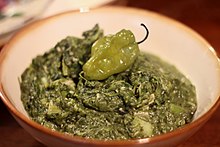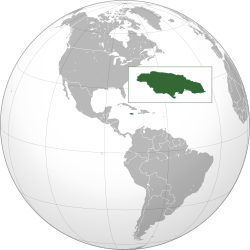Portal:Jamaica
The Jamaica Portal
Jamaica (/dʒəˈmeɪkə/ jə-MAY-kə; Jamaican Patois: Jumieka [dʒʌˈmie̯ka]) is an island country in the Caribbean Sea and the West Indies. At 10,990 square kilometres (4,240 sq mi), it is the third largest island—after Cuba and Hispaniola—of the Greater Antilles and the Caribbean. Jamaica lies about 145 km (90 mi) south of Cuba, 191 km (119 mi) west of Hispaniola (the island containing Haiti and the Dominican Republic), and 215 km (134 mi) south-east of the Cayman Islands (a British Overseas Territory). With 2.8 million people,0 Jamaica is the third most populous Anglophone country in the Americas (after the United States and Canada), and the fourth most populous country in the Caribbean. Kingston is the country's capital and largest city. Most Jamaicans are of Sub-Saharan African ancestry, with significant European, East Asian (primarily Chinese), Indian, Lebanese, and mixed-race minorities. Because of a high rate of emigration for work since the 1960s, there is a large Jamaican diaspora, particularly in Canada, the United Kingdom, and the United States. The country has a global influence that belies its small size; it was the birthplace of the Rastafari religion, reggae music (and such associated genres as dub, ska and dancehall), and it is internationally prominent in sports, including cricket, sprinting, and athletics. Jamaica has sometimes been considered the world's least populous cultural superpower. (Full article...) Selected article -The music of Jamaica includes Jamaican folk music and many popular genres, such as mento, ska, rocksteady, reggae, dub music, dancehall, reggae fusion and related styles. Reggae is especially popular through the fame of Bob Marley. Jamaican music's influence on music styles in other countries includes the practice of toasting, which was brought to New York City and evolved into rapping. British genres such as Lovers rock, jungle music and grime are also influenced by Jamaican music. (Full article...)Did you know (auto-generated)
Selected biography -James Chambers, OM (born 30 July 1944), known professionally as Jimmy Cliff, is a Jamaican ska, rocksteady, reggae and soul musician, multi-instrumentalist, singer, and actor. He is the only living reggae musician to hold the Order of Merit, the highest honour that can be granted by the Jamaican government for achievements in the arts and sciences. Cliff is best known among mainstream audiences for songs such as "Many Rivers to Cross", "You Can Get It If You Really Want", "The Harder They Come", "Reggae Night", and "Hakuna Matata", and his covers of Cat Stevens's "Wild World" and Johnny Nash's "I Can See Clearly Now" from the film Cool Runnings. He starred in the film The Harder They Come, which helped popularize reggae around the world, and Club Paradise. Cliff was one of five performers inducted into the Rock and Roll Hall of Fame in 2010. (Full article...)General images -The following are images from various Jamaica-related articles on Wikipedia.
This is a Good article, an article that meets a core set of high editorial standards.
The 1944 Jamaica hurricane was a deadly major hurricane that swept across the Caribbean Sea and Gulf of Mexico in August 1944. Conservative estimates placed the storm's death toll at 116. The storm was already well-developed when it was first noted passing westward over the Windward Islands into the Caribbean Sea on August 16. A ship near Grenada with 74 occupants was lost, constituting a majority of the deaths associated with the storm. The following day, the storm intensified into a hurricane, reaching its peak strength on August 20 with maximum sustained winds of 120 mph (195 km/h). At this intensity, the major hurricane made landfall on Jamaica later that day, traversing the length of the island. The damage wrought was extensive, with the strong winds destroying 90 percent of banana trees and 41 percent of coconut trees in Jamaica; the overall damage toll was estimated at "several millions of dollars". The northern coast of Jamaica saw the most severe damage, with widespread structural damage and numerous homes destroyed across several parishes. In Port Maria, the storm was considered the worst since 1903. Land interaction weakened the hurricane, and the storm maintained this lessened intensity as it passed the Cayman Islands, producing measured gusts of 80–90 mph (130–140 km/h). On August 22, the hurricane moved ashore the Yucatán Peninsula near Cozumel and eventually emerged into the Bay of Campeche as a tropical storm. On August 24, the storm made landfall for a final time near Tampico, Mexico, bringing with it heavy rains that caused flooding throughout the coasts of Veracruz and Texas, killing 12. The storm dissipated over the mountainous terrain of inland Mexico later that day. Heavy rains were reported across the Rio Grande Valley, causing minor flooding. A tornado produced by the storms killed one person in McCook, Texas and injured fifteen others. (Full article...)Selected picture - An Air Jamaica Airbus A340-300 (registration 6Y-JMP) landing at London Heathrow Airport, England
Selected cuisines, dishes and foods - Callaloo (/ˌkæləˈluː/ KAL-ə-LOO, Jamaican Patois: [kalalu]; many spelling variants, such as kallaloo, calaloo, calalloo, calaloux or callalloo) is a plant used in popular dishes in many Caribbean countries, while for other Caribbean countries, a stew made with the plant is called callaloo. Cuisines including the plant Callaloo or dishes called callaloo varies throughout the Caribbean. In countries such as Trinidad and Tobago or Grenada, the dish itself is called callaloo, and uses taro leaves (known by many local names such as 'dasheen bush', 'callaloo bush', or 'bush') or Xanthosoma leaves (known by many names, including cocoyam and tannia). Since the leaf vegetable used in some regions differs, some confusion can arise among the vegetables with the dish itself. This, as is the case with many other Caribbean dishes, is a remnant of West African and Taino cuisine. (Full article...)
More did you know
Selected listsTopicsCategoriesRelated portals
WikiProjectsGeographical:
History and Society:
Tasks
Associated WikimediaThe following Wikimedia Foundation sister projects provide more on this subject:
More portals | ||||||||||||





















































